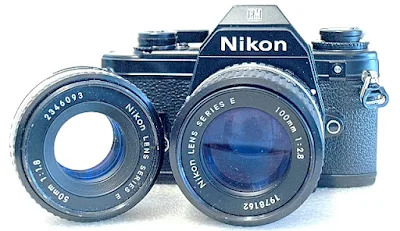Designed by the renowned auto designer Giorgetto Giugiaro, who also designed the exterior of the Nikon F3 (1980), the Nikon EM was the smallest, lightest, most compact, and most affordable SLR camera from Nikon.
The camera is a very simple-to-use aperture-priority model with a center-weighted metering system, built primarily of copper and aluminum alloy, while the top and bottom plates are made of polycarbonate.
Operationally, the aperture-priority autoexposure camera works with a shutter range from 1 to 1/1000 second (plus B), flash X-sync is at 1/90 second, and accepts film speed from ISO 25 to 600. Metering is TTL (Through-the-Lens) center-weighted. The Nikon EM is compatible with the MD-E Motor Drive unit.
Being an aperture-priority AE camera, shutter speed selection on the camera is not an option. What you have is only a minimalist dial with which you set the shutter selection settings to B, M90, and Auto. Metering is activated with a slight press of the shutter button and stays switched for a few seconds after you remove your finger from the button.
Nikon EM HP5 results
I purchased this Nikon EM via ebay in December. Threw on a 50mm f1.8 and a roll of Ilford HP5 to see how it did.Most of the shots came out nice and I printed a few to share, however a couple have dark bars along the long edge, indicating a shutter curtain issue of some kind.
Unique to the Nikon EM is the fact that, with the batteries removed (or when the battery is depleted), you still can do your timed exposure shots with the shutter dial set to 'B', shoot at the mechanical speed of 1/90 sec (M90), or at the default speed of 1/1000 second when the shutter speed dial set to 'Auto'.
Basic Camera Features
Being the runt of the series also means that the EM does not have all the sophistication that some of the other models have. TTL metering, as mentioned earlier, is a center-weighted average, favoring the 12mm diameter area as etched on the viewscreen, and a negative 2-stop compensation is activated when you press and hold the Exposure Compensation button while taking the shot.
The front of the camera is occupied by the slightly off-center Ai-S lens mount housing, the self-timer switch set to its left, the lens release button on the right, the exposure compensation button located just below the film rewind crank mechanism, and the neckstrap eyelets on each top edge.
On the top plane, from left to right, is the film ISO dial integrated with the film rewind crank, which in itself is also the pull-up latch control for opening the film back. A hot shoe sits on top of the pentaprism, and on the right, the shutter release button, shutter setting selector, and film forward crank combination. Complementing the top plate are the battery check button, battery strength LED, film counter window, and film plane indicator icon.
The film back is plain, aside from the viewfinder window located at the back of the top plate, and a film memo tab on the film back itself.
On the bottom, plates are the hot shoe socket, battery chamber cover, film rewind release button, motor drive coupling, and electrical contacts.
The film box is a standard load type where you have to insert the film tab into a slot on the take-up spool before doing the customary two-blank shots to move the film to frame one (after closing the film back, of course).
Viewfinder Readout
The Nikon EM is fitted with a fixed Nikon 'K' screen, which is a matt-fresnel field with a split-image rangefinder spot surrounded by a 12mm diameter center-weighted metering reference circle. Field coverage is approximately 92% of the picture field.
A shutter speed scale and exposure needle are located on the right of the viewfinder screen, with the needle showing the shutter speed at which the shot will be taken. Adjusting the aperture opening of the lens will vary the shutter speed accordingly.
Warning for overexposure, where the shutter speed setting is beyond the 1/1000 second mark, or camera shake, where the shutter speed is below the 1/30 second hand-holdable threshold, will be warned by a double 'beep' and the exposure needle occupying the red zones at the top or bottom of the shutter speed scale.
Battery
The Nikon EM requires a pair of SR or LR44 button cells to power the AE functions of the camera. A definite advantage of using the camera is when the batteries are flat or depleted. Without the batteries or with the batteries removed, the Nikon EM can still be used for shots at the B, M90, and 'Auto' settings, where the shots are taken at 1/1000 second.
Camera Body Weight
The Nikon EM has a body weight of 460 grams without batteries and measures 135mm wide, 86mm tall, and 54mm deep.
Nikon Series E Lenses
Complementing the launch of the Nikon EM (and the FG and FG20 later), Nikon also launched a series set of small, lightweight, and affordable Nikon Series E lenses which include the 28mm F2.8, 35mm F2.5, 50mm F1.8, 100mm F2.8, 135mm F2.8 primes, and 36-72mm F3.5, 36-72mm F3.5, and 70-210mm F4.0 zooms.
Though small and compact, these lenses have very similar optical formulas and feature the same F-mount as other Nikkor lenses. They can be used on any AI-spec Nikon SLR bodies, and at least a pair of them, the 50mm F1.8 and 100mm F2.8, are acknowledged for their performance.
Reverse the equation, and you will find that the Nikon EM is equally capable of being used with nearly all Nikon F bayonet mount (introduced in 1959) lenses supporting the Automatic Indexing (AI) feature (introduced in 1977). Ai-S lenses can be used for full aperture TTL metering, while pre-Ai-S lenses are used stopped down.
Using the Camera
Keeping in mind that you can use nearly all of Nikon's F-mount Ai, pre-Ai, and AI-S lenses on the camera, having the camera as a backup unit, a robust and lightweight one at that, is always a keen proposition.
The camera is equally adept for beginners, as well as digital photographers who are coming back to film. And with its low capital outlay and easy availability, the camera is never too hard to find.





















No comments:
Post a Comment